Filling a blank wall can transform a drab space into a canvas that reflects personal style and adds vibrancy to a room. Homeowners and decorators face the challenge of choosing the right elements that both express their tastes and complement the room’s existing decor. With a plethora of options ranging from art pieces and shelving to fabric and lighting, selecting the right combination can seem daunting. However, with a strategic approach, they can turn an empty wall into a focal point that enhances the overall aesthetic appeal of a space.

Understanding the scale of the wall and the visual effect one wants to achieve is essential. A large, expansive wall may call for a single oversized piece or a collection of smaller items arranged with intention. Conversely, a smaller space might benefit from simple, yet bold items that command attention without overwhelming the area. It is important to consider the interplay of colors, textures, and patterns, ensuring they contribute to the desired ambiance of the room.
Selecting the right pieces for a blank wall also involves considering the room’s functionality. In a living room or hallway, a gallery wall featuring a variety of art styles can stimulate conversation and interest. In a home office or study, shelving that holds books and personal mementos can add a layer of functionality while also filling the space aesthetically. They should consider the room’s lighting, as this can impact how wall decorations are viewed and experienced throughout the day. With thoughtful consideration of these elements, they can turn a blank wall into an intentional and cohesive design statement.
Understanding Blank Wall Challenges
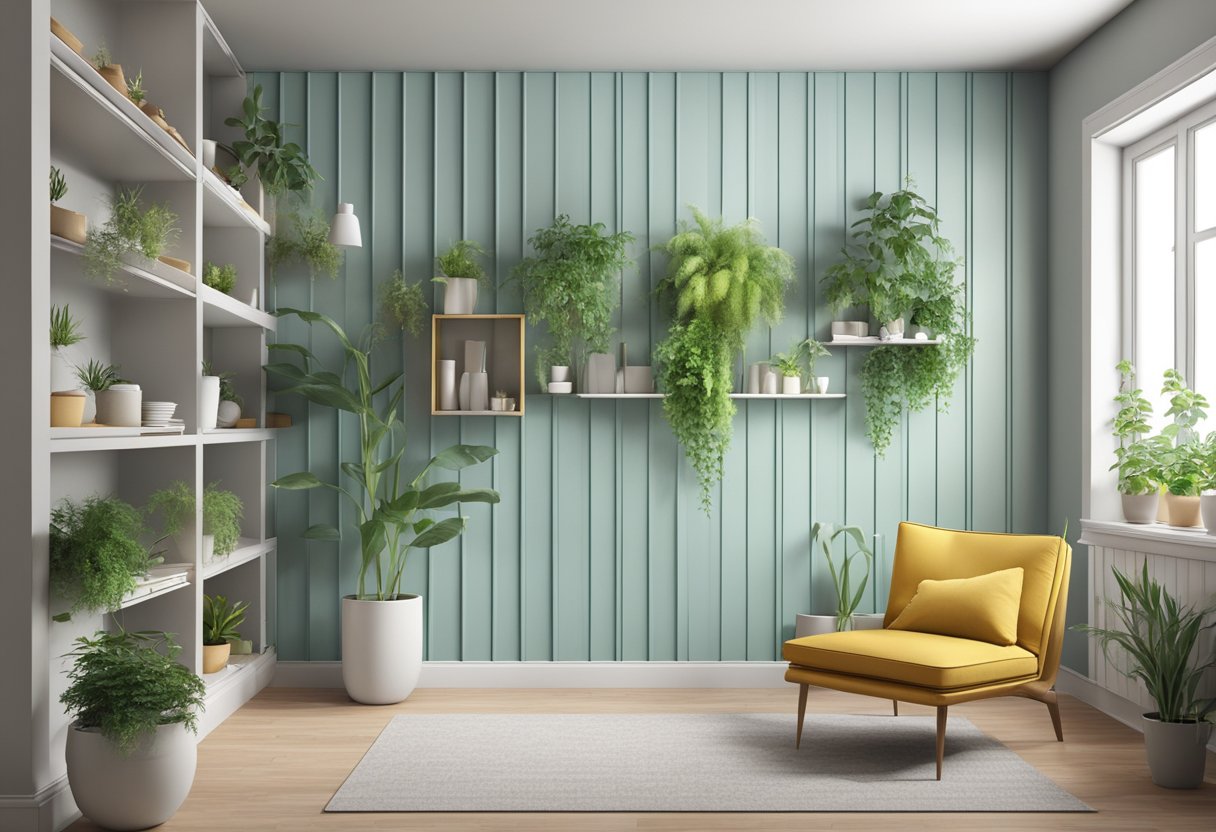
Filling a blank wall requires careful consideration of the space’s dimensions and the room’s intended use. These factors heavily influence the choice of decorations.
Assessing Your Space
One must measure the wall’s height and width to understand the available canvas. Dimensions directly affect the scale of potential wall decorations:
- Width: Measure in feet or meters depending on preference.
- Height: Note any deviations caused by features like moldings or fixtures.
Considering Room Function
The room’s function should dictate the formality and practicality of the wall decor.
| Room Type | Decor Approach |
|---|---|
| Living Area | Engaging and inviting pieces |
| Office | Functional, inspiring items |
| Bedroom | Tranquil and personal themes |
Each space demands a different treatment that complements its purpose.
Exploration of Wall Decorating Styles
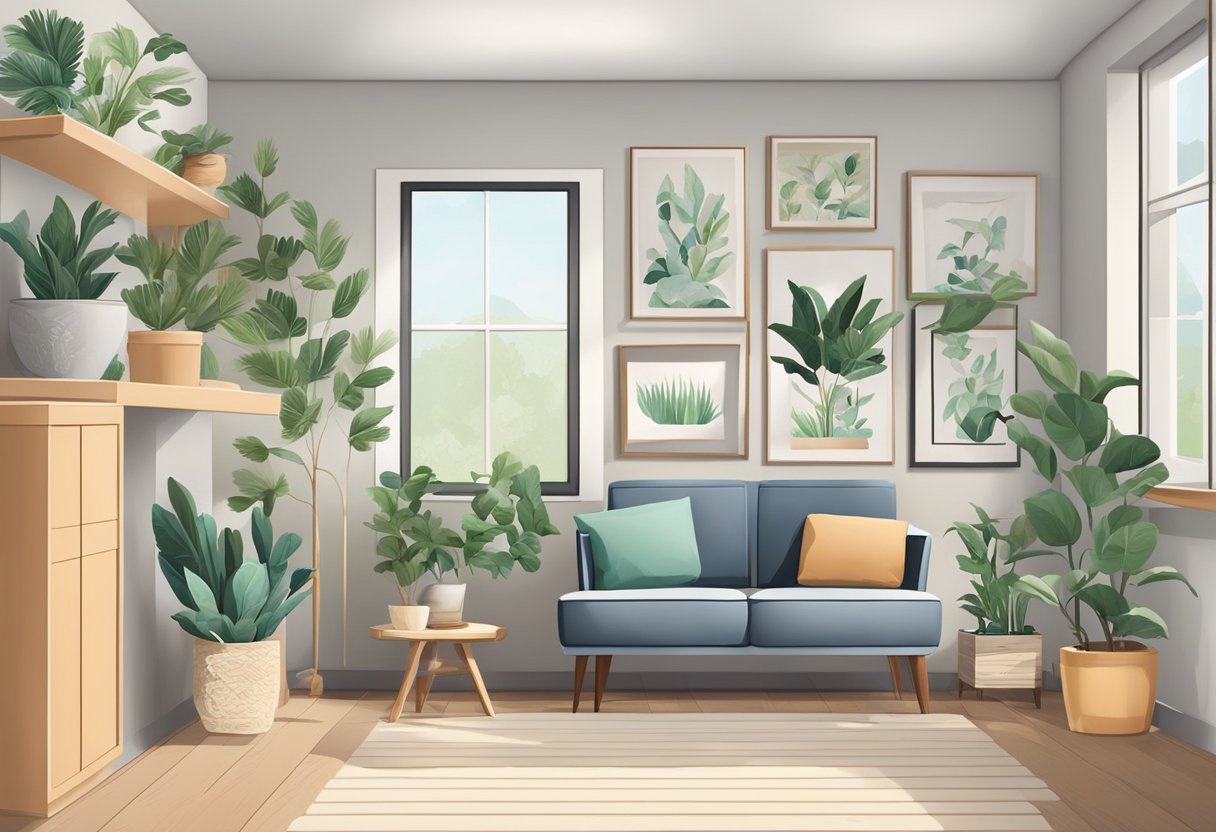
Identifying the appropriate wall decorating style can significantly alter the ambience of a room. This section will walk through various styles, providing an outline of their core elements for decorating a blank wall.
Contemporary
Contemporary style emphasizes a clean and uncluttered look, often featuring a monochromatic color palette with bold, contrasting accents. It’s about highlighting space rather than things.
- Color Scheme: Neutral with bold accents
- Key Characteristics:
- Sleek, glossy finishes
- Geometric shapes and lines
- Statement art or photography
Minimalist
In Minimalist decorating, less is more. This style is about uncluttered spaces, functional furniture, and a monochromatic color base, often punctuated with strategic use of texture and light.
- Color Scheme: Monochrome, focusing on black, white, and grays
- Key Characteristics:
- Subtle textures
- Simple, functional pieces
- Open, airy layouts
Bohemian
Bohemian style is free-spirited and draws on various eclectic and global influences. It uses the wall as a canvas to display a mix of patterns, colors, and artful objects.
- Color Scheme: Rich and vibrant colors
- Key Characteristics:
- Layered textiles and patterns
- Handmade or vintage items
- Cultural artwork or tapestries
Rustic
The Rustic style brings the essence of the outdoors inside, evoking a warm, natural, and comfortable atmosphere. It often features raw and natural materials.
- Color Scheme: Earthy and natural tones
- Key Characteristics:
- Reclaimed wood or stone
- Nature-inspired art
- Textured fabrics, like burlap or linen
Creation of a Gallery Wall
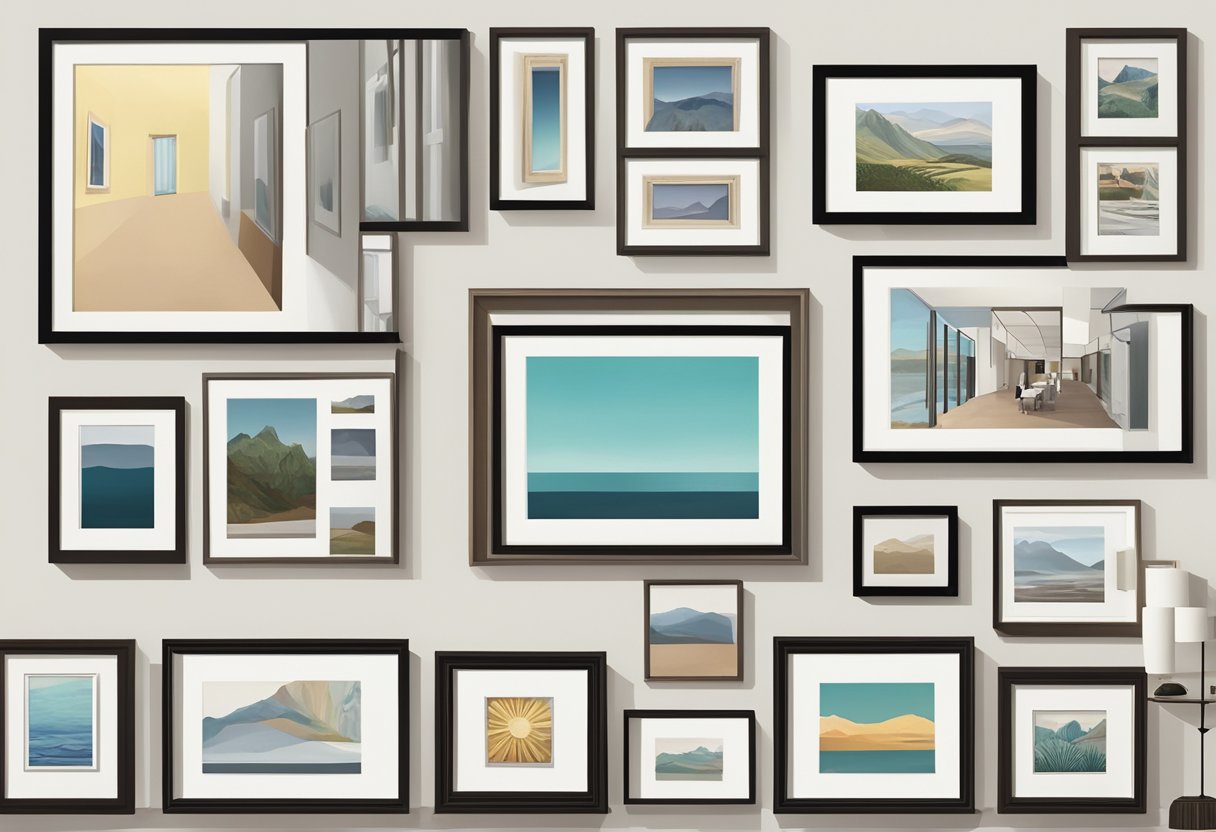
Creating a gallery wall can transform a blank space into an area of interest. It involves choosing artworks, arranging frames strategically, and employing precise hanging techniques.
Selecting Artwork
The selection of artwork is critical for a gallery wall. When selecting pieces, consider a unifying element, such as color scheme, theme, or art style. Artwork variety can include:
- Paintings
- Photographs
- Illustrations
- Prints
Ensure the collection is cohesive yet diverse enough to maintain interest.
Arranging Frames
Once selection is complete, the arrangement of frames comes next. Lay frames on the floor to experiment with configurations. Possible arrangement patterns include:
- Grid pattern
- Salon style
- Linear arrangement
Spacing between frames should be consistent, ranging from 2 to 5 inches, to create harmony.
Hanging Techniques
The final step is hanging. For secure and accurate hanging of frames, consider the following techniques:
- Use a level to ensure pictures hang straight.
- Employ wall anchors for heavier pieces to prevent wall damage.
- Picture hanging hooks can provide support without large nail holes.
Test the arrangement with paper cutouts taped to the wall before final placement to make adjustments as needed.
Large-Scale Art as a Focal Point
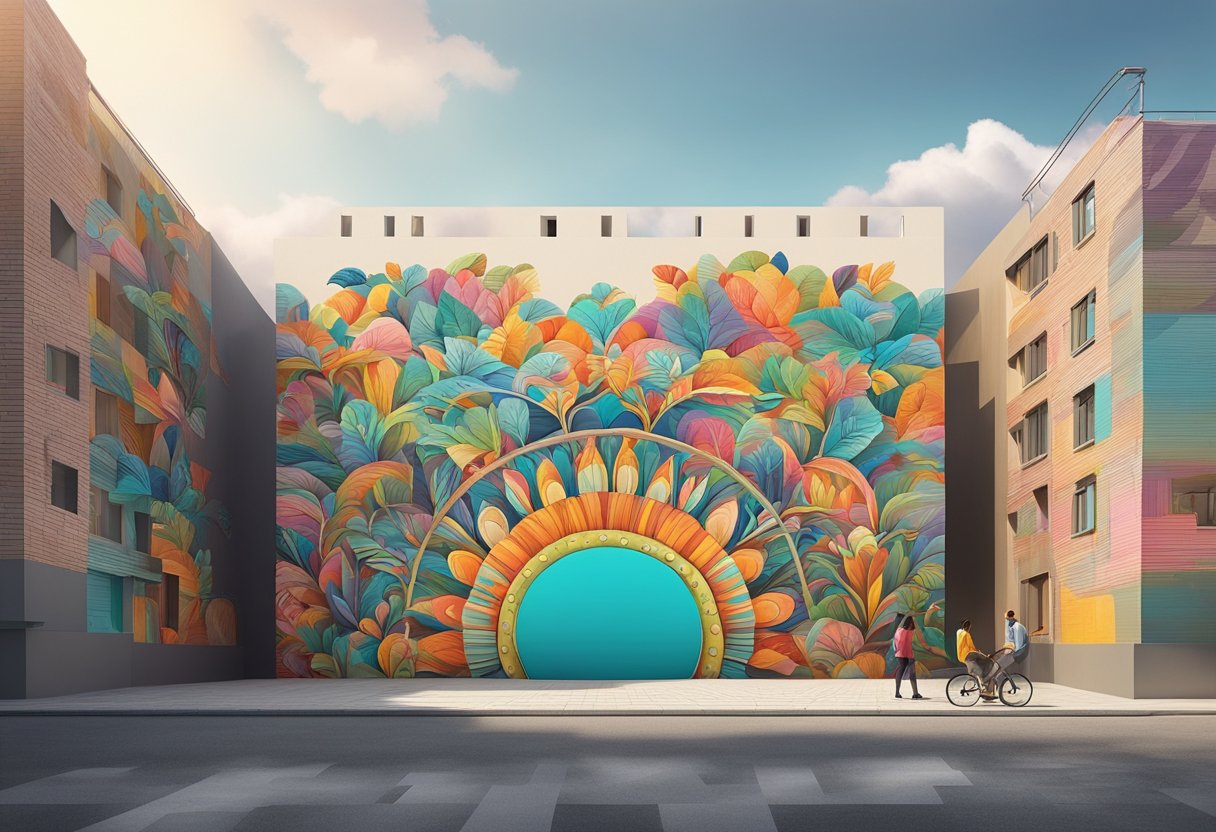
Large-scale art can transform a blank wall into an engaging visual centerpiece. The right artwork serves as a statement piece that anchors the room.
Choosing the Right Piece
One must consider the art’s subject, color palette, and style to ensure it complements the existing room’s décor. Size is crucial; the piece should be proportional to the wall space. For a balanced look, a general rule is that art should cover two-thirds to three-quarters of the wall. One may opt for a single oversized painting or a series of large prints.
Themes and colors should resonate with the room’s aesthetic and the individual’s personal taste. Art that echoes the color scheme of the space helps to create a cohesive look. Themes can range from abstract to landscapes, depending on the ambiance one aims to create.
Placement Strategies
Centering the artwork at eye level, which is roughly 57 to 60 inches from the floor, ensures it can be enjoyed comfortably from a standing position. When positioning above furniture, leave a 6- to 8-inch gap between the bottom of the art and the top of the piece to create a visually pleasing anchor.
For correct alignment, use a level and measure distances carefully. If the art is exceptionally heavy, secure it with appropriate wall anchors or seek professional installation for safety. If using multiple pieces, maintain a consistent spacing of 2 to 3 inches between each for a unified look.
Incorporating Shelving and Storage

Shelving and storage solutions are essential for both organizing belongings and enhancing the aesthetics of a blank wall. They should provide practical use while complementing the room’s overall design.
Functional Design
When integrating shelving, one must consider the load-bearing capacity and the material’s suitability for intended items. Floating shelves made of sturdy hardwood can hold books and heavier objects, while sleek metal brackets paired with glass shelves offer a lighter option suitable for decorative pieces.
- Load Capacity:
- Heavy-Duty: Hardwood, Metal supports
- Light: Glass, Minimalist brackets
- Materials:
- Wood: Varieties like oak, walnut
- Metal: Stainless steel, aluminum
- Glass: Tempered for safety
Visual Harmony
Shelves should harmonize with the room’s color palette and style. For a cohesive look, one could match the shelving material with other furniture pieces. Incorporating varying shelf heights can create an engaging visual flow, while maintaining uniform spacing between shelves establishes a clean, orderly appearance.
- Color Coordination: Match shelf color to room accents
- Height Variation: Stagger shelves to draw the eye upward
- Spacing Consistency: Uniform gaps between shelves for a tidy look
Textural Elements and Wall Hangings
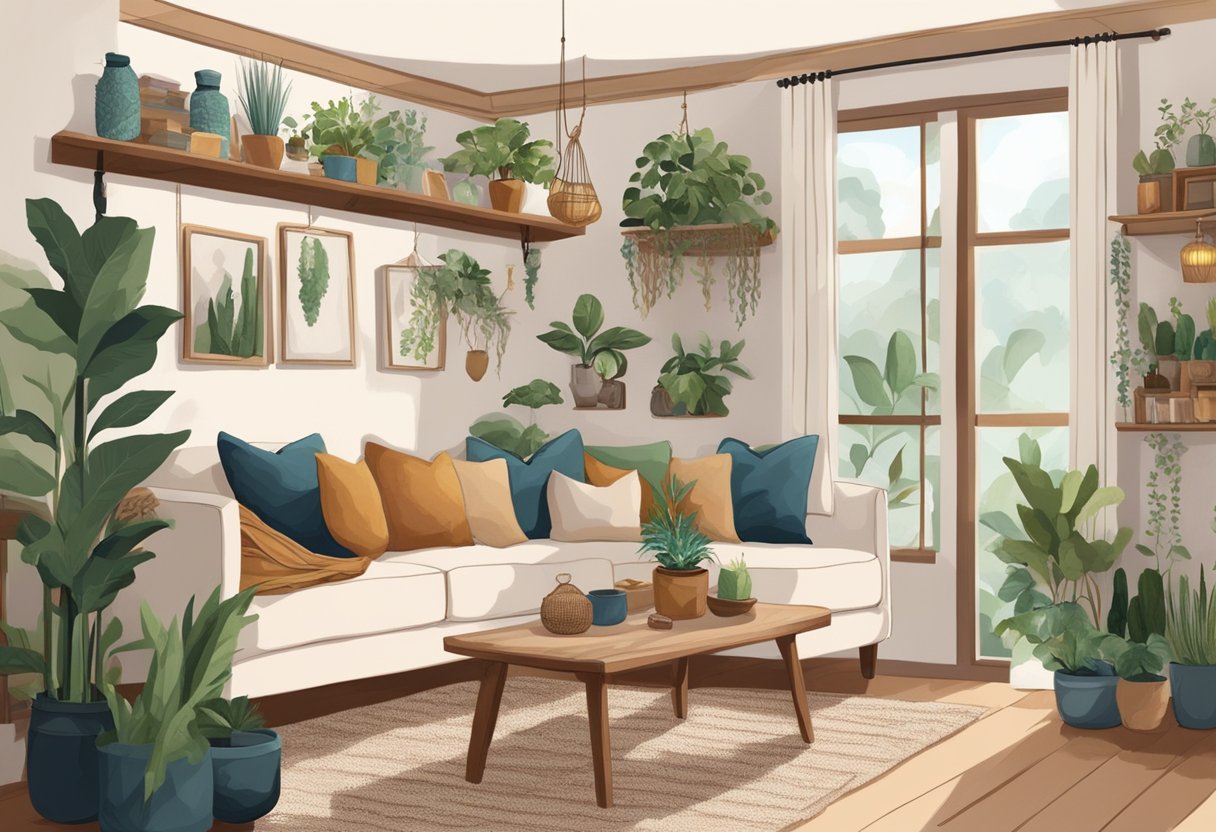
Adding texture to a wall can transform the energy and mood of a space. Textural wall hangings and fabric elements are practical solutions that add warmth and dimension.
Fabric and Tapestries
Fabrics and tapestries can serve as focal points in a room, filling a wall with color, pattern, and texture. When selecting a tapestry, one should consider the scale in relation to the wall size. Small tapestries can be grouped, while larger ones command attention on their own. Here are materials often used:
- Cotton: Versatile and easy to clean, cotton tapestries offer a casual look.
- Silk: Adds a lustrous sheen and elegance to the wall.
- Wool: Provides rich texture and warmth, ideal for creating a cozy atmosphere.
Hanging methods vary, from sleek metal rods to natural wooden dowels, adding another layer of texture.
Mixed Media
Mixed media wall hangings combine different materials like metal, wood, glass, and textiles to create a rich, tactile experience. They can either be abstract or representational, depending on the artist’s vision. Some popular combinations include:
- Metal + Wood: Contrasting the industrial feel of metal with the organic warmth of wood.
- Textile + Glass: Combining the softness of textiles with the smooth, reflective qualities of glass.
When integrating mixed media, pay attention to balance and composition to ensure each material stands out without overwhelming the space.
Innovative Use of Paint and Wallpaper
When transforming a blank wall, paint and wallpaper present endless creative possibilities. Utilizing these materials can revolutionize the dynamic of any room.
Accent Walls
They can create a focal point in a room. For a bold statement, one might select a vibrant paint color or a graphic wallpaper pattern that contrasts with the other walls. Consider using a rich, deep color like navy blue or a striking emerald green to add depth and interest.
- Color Choices:
- Bold Reds
- Deep Blues
- Bright Yellows
- Wallpaper Patterns:
- Geometric
- Floral
- Abstract
DIY Patterns
One doesn’t need to rely on store-bought designs for a unique look. With painter’s tape, one can create geometric designs or stripes directly on the wall before painting. Another option is to hand-stencil a pattern using a homemade or purchased stencil for a personalized touch.
- Materials Needed for Tape Designs:
- Painter’s Tape
- Level
- Paint
- Steps for Stenciling:
- Secure the stencil to the wall.
- Dab paint onto the stencil.
- Carefully remove the stencil and repeat.
Incorporating Lighting Solutions
When considering lighting options for a blank wall, it is essential to decide on the ambiance desired and the specific features one wishes to highlight.
Ambient Lighting
Ambient lighting provides a room with its overall light. Sconces, wall-mounted fixtures, and LED strips are popular choices to establish a warm, even illumination. For example, one may install vertical sconces on either side of the wall to create a soft, diffused light that spreads evenly across the area.
| Lighting Type | Description | Ideal Placement |
|---|---|---|
| Sconces | Offer a soft, indirect light | Flanking artwork |
| LED Strips | Provide continuous illumination | Along the wall perimeter |
Feature Lighting
Feature lighting accents specific areas, drawing attention and adding character. Pinpointing an artwork piece with a dedicated picture light can bring its details to life. Adjustable track lighting is another versatile option to spotlight various elements on the wall, allowing flexibility with directional focus.
- Spotlights: Ideal for casting an intense beam on focal points.
- Picture Lights: Attach above artwork to highlight textures and colors.
| Lighting Fixture | Purpose | Placement Tip |
|---|---|---|
| Track Lighting | Directional focus on features | Install above or across from the desired spot |
| Picture Lights | Emphasize artwork | Mount just above the piece |
Integration of Technology and Media
When filling a blank wall, incorporating technology and media can create a multifunctional space. These elements can enhance the room’s ambience and utility.
Smart Home Gadgets
Wall-Mounted Control Panels: Many smart home gadgets come with sleek wall-mounted control panels that can manage lighting, temperature, security, and more. For example, the Ecobee SmartThermostat provides temperature control and sensors, while the Amazon Echo Show can serve as a central hub for other smart devices.
- Digital Art Displays: Companies like Meural and Canvas II offer digital frames that can showcase art collections or personal photos, and can be easily updated for new displays.
Entertainment Systems
Television and Sound Systems: A blank wall is an ideal location for a flat-screen television. Opt for models like the LG OLED or Samsung QLED for high-quality picture, and pair with a soundbar such as the Sonos Beam for immersive audio.
- Gaming Consoles and Accessories: Wall shelves or minimalist cabinetry can provide clean storage solutions for gaming consoles like the PlayStation 5 or Xbox Series X, keeping the gaming area organized and stylish.
Plant Life and Greenery Environments
Incorporating plant life into an indoor space brings a slice of nature into one’s home, creating a serene and lush environment. Thoughtful integration of plants can transform a blank wall into a living piece of art.
Indoor Gardens
An indoor garden can be an oasis of tranquility. To create one, begin by selecting a variety of plants that thrive in indoor conditions. Consider these factors:
- Light requirements: Ensure plants receive adequate light, whether through a nearby window or with grow lights.
- Potting: Choose pots with drainage holes to prevent waterlogging and root rot.
- Placement: Arrange plants at different levels using shelves or stands to add depth and interest.
Here is a table detailing some common plants suitable for indoor gardens:
| Plant Name | Light Requirements | Watering Frequency |
|---|---|---|
| Snake Plant | Low to moderate | Every 2-3 weeks |
| Pothos | Low to bright | Every 1-2 weeks |
| Spider Plant | Moderate to bright | Weekly |
| ZZ Plant | Low to moderate | Every 2-3 weeks |
Living Walls
A living wall transforms a blank wall into a vertical garden. Here’s how to achieve it:
- Choose a suitable wall for installation.
- Install a structural support, such as a frame or a modular panel system.
- Select plants that will flourish in the available light and create a visually appealing pattern.
- Install an irrigation system to maintain consistent moisture levels.
For a DIY approach, one can create pocket living walls using fabric planters attached to the wall and a manual watering routine. For a more advanced setup, integrated water systems can be installed for ease of maintenance.
Final Considerations and Maintenance
When selecting wall treatments, one must consider the longevity and ease of maintenance. These factors ensure that the aesthetic appeal is enduring and the wall remains in good condition.
Longevity and Flexibility
- Materials: Choose materials known for their durability, such as high-grade paint or quality wallpaper, to ensure longer life.
- Design: Opt for timeless designs or easily changeable accents to adapt as personal tastes or trends evolve.
Upkeep and Cleaning
- Routine Care: Establish a cleaning regimen using appropriate products; for painted walls, a gentle detergent and for wallpapers, a damp cloth.
- Damage Prevention: Keep items that may cause wear or discoloration away from wall surfaces, such as direct sunlight or furniture that might scratch.
By adhering to these considerations, one can ensure that their wall treatment remains as striking as the day it was completed.
